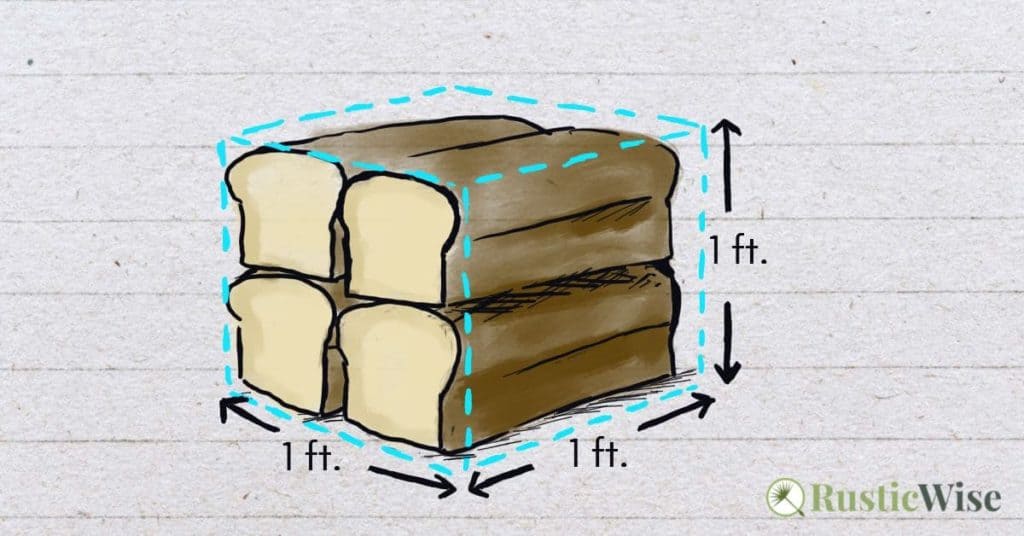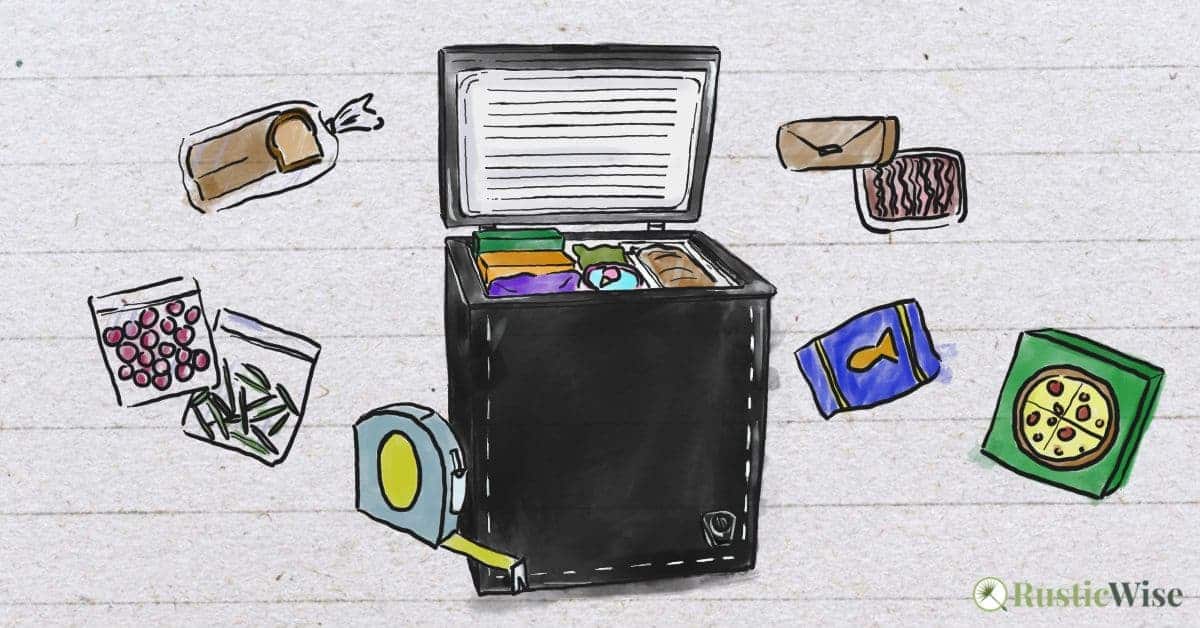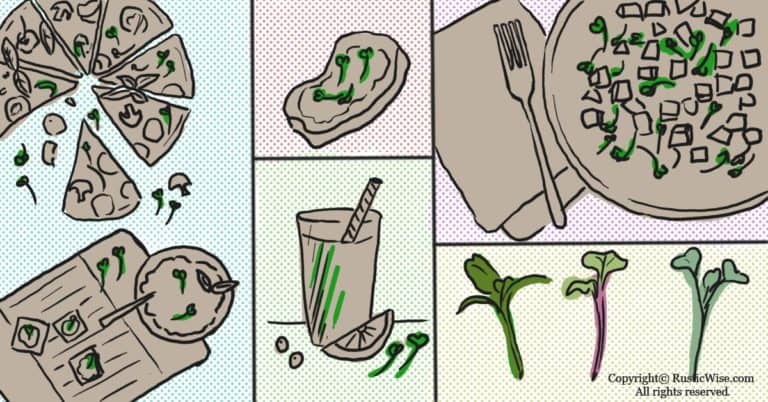How Much Will a Small Freezer Hold (6 to 9 Cubic Feet)?
RusticWise is supported by its readers. When you purchase through links on our site, we may earn an affiliate commission. As an Amazon Associate, we earn from qualifying purchases. Thank You!
Are you looking to add a small freezer to your home? If you’re wondering how much a small freezer will hold, the answer is about 210–315 pounds (95–143 kilograms) of food. This would accommodate four to six people (based on the assumption that each person requires 1.5 cubic feet of food storage).
In terms of handy home appliances, freezers rank right up there alongside refrigerators and dishwashers. If you’re looking to add extra food storage, but don’t want a large deep freezer, a small freezer (between 6 to 9 cubic feet) may just be what you’re looking for.
Let’s look at whether small freezer would be right for you.
Standard freezer sizes
Standalone deep freezers come in four standard sizes¹. Determining the minimum size freezer for your household is a good start. In the “small” freezer category, 7 cubic feet freezers are a popular choice.
| Type | Freezer Capacity (cubic feet) |
|---|---|
| Compact | 3 to 5 cu. ft. |
| Small | 6 to 9 cu. ft. |
| Medium | 10 to 16 cu. ft. |
| Large | 17+ cu. ft. |
5 vs. 7 cubic feet freezer
If you’re deciding between buying a 5 or a 7 cubic feet freezer, here are some storage guidelines. A 5 cubic foot freezer holds roughly 175 pounds (79 kilograms) of food compared to a 7 cubic feet freezer, which holds about 245 pounds (111 kilograms) of food.
A 7 cubic feet freezer holds approximately 70 pounds (32 kilograms) of extra food.
You might like
Arctic King 7 cu. ft. Chest Freezer, Black
- Mechanical temperature control
- Dimensions: 32.1 x 21.7 x 33.5 inches
- Item Weight: 73 pounds
Found on Amazon
Check Current Price
Those in Canada and the UK should be taken to the product listing in your region.
7 vs. 10 cubic feet freezer
Looking for a bigger freezer? A 7 cubic feet freezer holds about 245 pounds (111 kilograms) of food compared to a 10 cubic feet freezer with a capacity of 350 pounds (159 kilograms).
A 10 cubic feet freezer holds about 105 pounds (48 kilograms) of extra food.
You might like
Commercial Chest Freezer – Kitma 9.6 cu. ft.
- Dimensions: 40.5 X 26.5 X 32.5 inches
- Two removable interior baskets
- Adjustable temperature control
Found on Amazon
Check Current Price
Those in Canada and the UK should be taken to the product listing in your region.
How to calculate freezer storage needs per person
The average person requires between 1.5–2.5 cubic feet of freezer storage space.
To calculate how much freezer space you’ll need, multiply the number of people in your household by 1.5–2.5 cubic feet.
Use this range of 1.5 to 2.5 as a guideline and adjust it according to your lifestyle and needs. For example, children would probably not require over 1.5 cubic feet of storage. If you stock up on freezer food, then you’ll probably want to multiply by 2.5 cubic feet.
How much will a small (6 to 9 cubic feet) freezer hold: different scenarios
We mentioned above that a general guideline is to multiply the number of people in your household by 1.5–2.5 cubic feet to determine your freezer storage needs.
Here’s a chart outlining a rough guideline of freezer storage needs based on household composition. To be on the safe side and allow for extra space, we’ve multiplied adults by 2.5, and children by 1.5.
A small (6 to 9 cubic feet) freezer is sufficient for a household with four to six people, depending on individual needs.
| Household | Freezer Storage Needs (cubic feet) |
|---|---|
| Two adults | 5 cu. ft. |
| Two adults, two young children | 8 cu. ft. |
| Two adults, three young children | 9.5 cu. ft. |
| Four adults | 10 cu. ft. |
How many pounds of food can 1 cubic foot hold?
A general guideline is that 1 cubic foot holds approximately 35 pounds (16 kilograms) of food.
Keep in mind that packaging and overall size play a large role in how much you can cram into 1 cubic foot. For example, 10 pounds of roast beef will probably take up less space than 10 pounds of bread.
How much food fits in 1 cubic foot?
If all these numbers are confusing, let’s look at what you can comfortably fit into: 1 cubic foot (1 foot X 1 foot X 1 foot).
Based on my own calculations, you can fit about four standard loaves of bread in 1 cubic foot (the loaves fit 2 X 2).

Things to consider when buying a freezer
There are many factors to consider when deciding on the proper freezer size. Your budget plays a large role, but let’s not forget about your basic household needs and preferences.
Household needs
Are you someone who likes to stock up on freezer meals to make meal prep time easier? Or, perhaps you’re only looking to store a bucket of ice cream and the occasional loaf of bread.
Depending on your household needs and lifestyle, you may require more freezer storage if you plan on:
- Freezing fresh fruits and vegetables from the garden
- Stock up on meat
- Stock up on bulk food items at the grocery store
Taking a realistic look at your household needs is one of the most important considerations when determining the freezer size.
Freezer style
There are two main styles of standalone freezers: upright freezer or chest freezer (aka box freezer).
An upright model looks similar to a standard refrigerator with a door that swings open from side-to-side. They have adjustable shelves. The upside to upright freezers is they take up less floor space and provide easy-access to food.
The downside to upright freezers is they hold less than chest freezers. According to Consumer Reports2, the shelves and bins of upright freezers take up about 20 percent more space than those in chest freezers.
Chest freezers have doors that open like a treasure chest. They have a greater storage capacity than upright models and hold more food per cubic foot. Food stays cooler better in a chest freezer. In case of a power outage, food stored in a chest freezer can keep cool for a longer time than an upright freezer. New or used chest freezers are typically less expensive than upright freezers.
The downside to chest freezers is they take up more floor space. It can also be more difficult to reach foods on the bottom. To keep frozen foods organized, consider buying freezer bins or wire baskets. A small chest freezer may keep the amount of frozen food you have more manageable.
Available space
The type of freezer you buy (upright vs. chest freezer) depends on how much floor space you have available. (Another option is to keep your freezer in the garage if possible.)
A small freezer appliance (between 6 to 9 cubic feet) may be just what you’re looking for.
Remember to allow for at least 1 inch of space between the back of the freezer and the wall, as well as several inches of clearance all around. This ensures adequate airflow and keeps your freezer in good running condition.
The ideal place to put a freezer is in a cool, dry area away from windows and sunlight, and other heat sources.
The importance of getting the right freezer size
Your goal when selecting the right freezer size is to get one that’s not too big, not too small—but just right.
Getting the right size helps to optimize freezer efficiency and maintain food safety.
Freezers that are too full have poor air circulation. Some foods stay cold, while others become warmer, which leads to potential food safety and temperature control issues. The freezer compressor also works harder when your freezer is too full. Aim to leave room at the top and along the sides of the freezer compartment for sufficient airflow.
Having extra frozen food storage at home brings peace of mind—something that’s well worth investing in!
Related questions
On the flip side, freezers that are too empty are more inefficient. While a bit of extra freezer space is okay, a vast space requires a lot of energy to keep cool continually.
If you want to fill up an empty freezer, use this hack.
Fill clean milk jugs or other juice containers with water (remember to leave space at the top for expansion). Ziploc bags filled with water or ice cubes will also work. When your freezer is sufficiently full, it prevents temperature fluctuations from occurring every time you open the door.
Tip: The sweet spot is to aim for a freezer that’s around 70-85 percent full3. This allows proper air circulation while also optimizing energy efficiency.
How much meat fits in a 7 cubic feet freezer?
One of the most common foods to stock up on is meat. With its short shelf life, and fluctuating prices, keeping a bit of extra meat in the freezer is a good idea.
Whether you hunt or source your own meat from a farmer, you might wonder how much meat fits into a 7 cubic feet freezer.
A general rule of thumb is that you can squeeze in roughly 35–40 pounds of meat per each cubic foot⁴.
A 7 cubic foot freezer could hold about 245–280 pounds (111–127 kilograms) of meat. This would comfortably fit a quarter beef with a bit of room to fit other frozen foods, too.
The takeaway: how much will a small freezer hold
A small freezer between 6 and 9 cubic feet will hold approximately 210–315 pounds (95–143 kilograms) of food and may be enough for four to six people. In terms of meat storage, a small freezer holds a quarter beef with a bit of room to spare. When deciding on a freezer, remember to consider your lifestyle needs and whether an upright model vs. chest freezer is right for you.
Can you keep a deep freezer in a garage?
There are several factors you need to consider before placing a freezer in a garage, such as whether the garage is heated vs. unheated, ambient temperature throughout the year, humidity, and sufficient space requirements.
For more information, check out our article on Can a Freezer Be Kept in an Unheated Garage?
What’s the ideal temperature for a deep freezer?
The U.S. Food & Drug Administration (FDA)⁵ recommends keeping your freezer temperature at 0 degrees Fahrenheit (-18 degrees Celsius) or lower. Foods properly packaged and stored at this temperature can, in theory, last indefinitely. However, most frozen foods may deteriorate in quality and taste (and likely develop freezer burn over time). So enjoy your frozen foods sooner rather than later!
How big is a standard freezer?
There’s not really a definitive “standard” size of freezer. But just to give you a rough idea, a standard refrigerator freezer (with a top-freezer) has a storage capacity of around 4–5 cubic feet.
The most popular standalone freezer sizes are: 3.5, 5, 7, and 10 cubic feet.
Keep in mind that people who live on farms and rural areas have varying needs than city dwellers. Space constraints are the biggest issue for many people in the city, which is why compact or small freezers are more common in urban areas. My husband grew up on a farm where they had two large freezer chests (18+ cubic feet), side-by-side.
How to measure and calculate freezer capacity
We measure freezers in cubic feet, a measurement of volume. (Picture a cube with sides that measure 1 foot.)
To calculate freezer capacity, measure the inside of your freezer’s length, width and height. (Convert your measurement to feet if you measured in inches or centimeters.)
Next, multiply the three numbers together (in feet): Length X Width X Height
The answer gives you a rough idea of your freezer capacity.
Check out related posts:
👉 How Much Will a Small Freezer Hold (6 to 9 Cubic Feet)?
👉 How Much Will a Medium Freezer Hold (10 to 16 Cubic Feet)?
👉 How Much Will a Large Freezer Hold (17+ Cubic Feet)?

References
- Lowe’s, Freezer Buying Guide, https://www.lowes.com/n/buying-guide/freezer-buying-guide. Accessed October 2021.
- Consumer Reports, Freezer Buying Guide, https://www.consumerreports.org/cro/freezers/buying-guide/index.htm. Accessed October 2021.
- Sears Home Services, 5 Most Common Freezer Problems and Solutions, https://www.searshomeservices.com/blog/5-most-common-freezer-problems-and-solutions. Accessed October 2021.
- Sparacio, Micah (23 March 2020). “How Much Beef Can I Fit in a Freezer?“, Cove Creek Farm. Accessed October 2021.
- U.S. Food & Drug Administration (FDA), Are You Storing Food Safely?, https://www.fda.gov/consumers/consumer-updates/are-you-storing-food-safely. Accessed October 2021.

Author: Theresa Tesolin
Theresa is co-founder of RusticWise. She helps people unleash their inner DIY spirit by encouraging them to get dirty and make or grow something from scratch.












